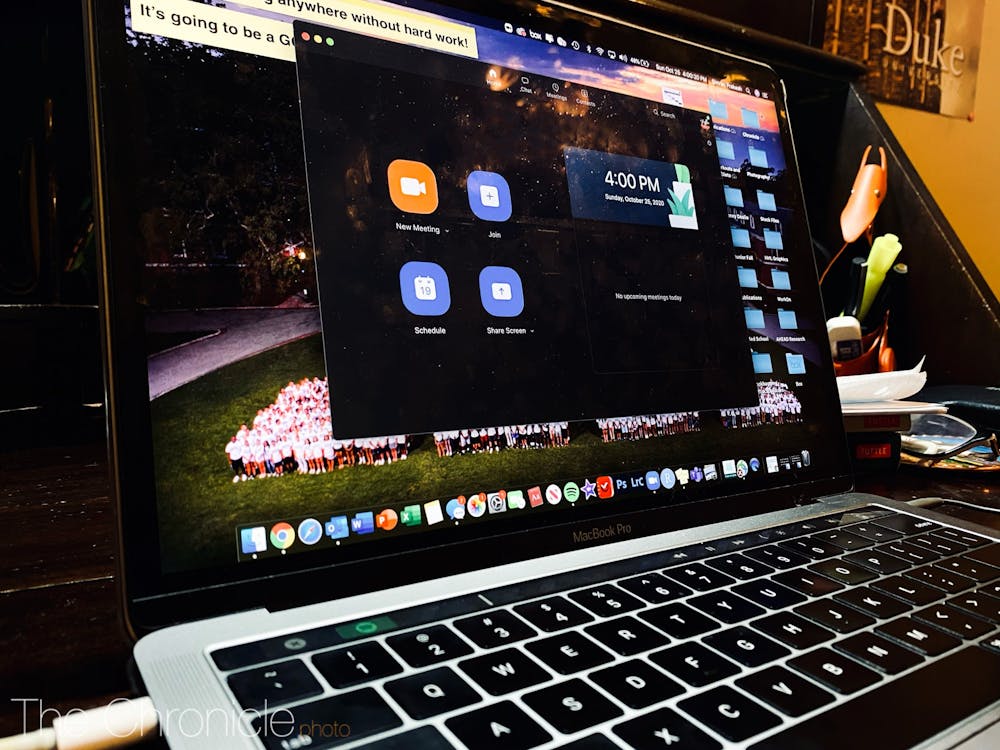Tired of scrambling to find a Zoom link for your fourth class of the day? Many professors are, too.
Undergraduate students have mixed feelings about online courses, some appreciating the lack of effort it takes to log onto a class and others frustrated by the lack of incentive to participate or even show up. Professors also have experienced the highs and lows of Zoom but many share one thing in common: they miss in-person teaching.
Kristin Goss, Kevin D. Gorter professor of public policy and political science, is teaching Political Analysis for Public Policy-Making this semester. After realizing that she would have to transition her class to an online format, Goss decided to rethink the structure of the course.
“My theory was that probably doing a big lecture class on Zoom would be suboptimal from the students’ perspective,” Gross said. “I wasn’t that interested in spending time doing a class that I didn’t think was going to go well from the start, so I decided to do something radical and figured that it would have some greater probability of success.”
Goss transformed the class into a seminar-style course with smaller sections in the place of a bigger lecture and an all-group session in place of a Friday discussion. The new structure facilitates a more tight-knit environment for students, but it has nearly tripled the number of hours Goss spends teaching each week.
“I do more or less the same class three times in a row on Monday, and then three times in a row on Wednesday, and then on Friday everyone is in the same class,” Goss said. She noted that she keeps Ricola cough drops on her desk because her throat is scratchy at the end of each day.
Despite the scratchy throat, Goss told The Chronicle that she hasn’t quite experienced Zoom fatigue.
“It’s more time teaching, which is time that I’m not doing other things, but I don’t know if that’s a Zoom thing per se,” she said. “I could just be teaching long hours in the classroom too and have the same effects.”
Goss further explained that she is willing to spend more time on Zoom if it translates to a better class experience for her students.
“We do not like teaching this way any more than you guys like learning this way, so my thought was that if there’s something I can do to improve the experience in some ways even though we know we’ll be sacrificing in other ways, then it was worth that commitment of time,” she said.
Goss is glad she made the change to her course and “[has] no regrets at all.”
On the other hand, Stephen Smith, professor of the practice of African and African American studies, shared that he does not spend much time on Zoom at all.
“In comparison to what my colleges have gone through, I was largely spared. I didn’t come back with any Zoom fatigue,” Smith said.
Smith was on sabbatical doing research in Africa throughout 2020 and revealed how his pandemic experience contrasted with most other professors. “Moving from here to Europe and then on to Africa, each time I had to readapt,” Smith said.
This semester, Smith is teaching two seminar courses: Conflict Analysis in Africa (Case Studies) and War and Public Health in Africa. He registered these classes as hybrid so that his students could share their opinions on which class structure they preferred. They “unanimously and quite enthusiastically” wanted in-class teaching, according to Smith.
Smith reasoned that if he could “travel and sit in bush taxis in the Ivory Coast,” then he could surely teach students in person, as long as they were cautious and followed safety protocols inside and outside of the classroom.
Denise Comer, professor of the practice of Thompson Writing Program, is teaching two classes on Zoom this semester: Geographic Muses—a Writing 101 course for first-years—and a Stress, Wellness, and Identity writing course.
Comer said that she didn’t experience as much Zoom fatigue from teaching classes as she did from meetings.
“I think you’re probably in Zoom class settings a lot more than I am each week. But faculty, we do have meetings a lot. There are some days where I’m in meetings for six to eight hours, and it’s hard to concentrate,” Comer said.
Comer explained that for her summer and fall 2020 courses, she decreased the amount of class time to prevent Zoom fatigue amongst students; however, the lack of face-to-face connection as a result of asynchronous teaching led her to revert back to mostly synchronous Zoom classes this semester.
Get The Chronicle straight to your inbox
Sign up for our weekly newsletter. Cancel at any time.
Despite this, Comer is still trying to find other ways to reduce the levels of Zoom fatigue for her students. She tries to integrate activities “relevant to the pedagogy” of the course that help reduce tiredness, like stretching, meditating and walking around.
Although Goss, Smith and Comer all agreed that in-person teaching and learning would be preferable, Goss and Comer did point out some of the positive aspects of virtual learning via Zoom.
For example, Goss appreciates how it’s much easier to bring in guest speakers. Comer shared how Zoom has made it easier for her to learn her students’ names faster. She also mentioned the time-savings resulting from the use of Zoom for class meetings.
“I just walk to my [home] office and teach instead of showering, getting dressed, driving to Duke, parking at Duke,” she said.

Madeleine Berger is a Trinity senior and an editor at large of The Chronicle's 119th volume.

